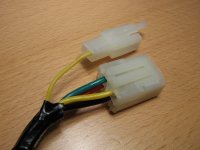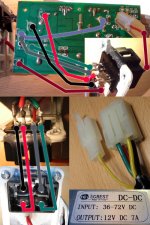scootergrisen
100 W
- Joined
- Feb 26, 2018
- Messages
- 154
Why does my DC to DC converter seem to have 3 wires for 48V+?
It has a connect with 4 wires (green, red, yellow, black) and a separate connect with red.
Seems like green (-) and red (48V+) is always connected to the battery.
And yellow gives 48V+ when ignition is ON.
Black is 12V+ when ignition is ON.
And red in separate connector gives 48V+ when ignition is ON.
Red in separate connector seems to only supply the controller. So called "Power Supply for Digital stage of Controller" in the manual with a thin wire so not the power for the motor, just the electronic chips and stuff in the controller guess.
Is this because the controller needs a more stable 48V+ so it have its own supply that is not used by anything else?
Or why does the controller have multiple wires with 48V+?
More pictures: https://scootergrisen.org/forum/viewtopic.php?f=3&t=3602


It has a connect with 4 wires (green, red, yellow, black) and a separate connect with red.
Seems like green (-) and red (48V+) is always connected to the battery.
And yellow gives 48V+ when ignition is ON.
Black is 12V+ when ignition is ON.
And red in separate connector gives 48V+ when ignition is ON.
Red in separate connector seems to only supply the controller. So called "Power Supply for Digital stage of Controller" in the manual with a thin wire so not the power for the motor, just the electronic chips and stuff in the controller guess.
Is this because the controller needs a more stable 48V+ so it have its own supply that is not used by anything else?
Or why does the controller have multiple wires with 48V+?
More pictures: https://scootergrisen.org/forum/viewtopic.php?f=3&t=3602





